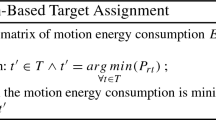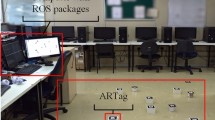Abstract
In this paper we present some results obtained with a troupe of low-cost robots designed to cooperatively explore unknown structured orthogonal environments. In order to improve the covering of the explored zone the robots show different behaviours (routine, normal and anxious) and cooperate by transferring each other the perceived environment when they meet; therefore, not all the information of the non-returning robots is lost provided that they had encountered robots that safely returned. The returning robots deliver to a host their perceived and communicated (by other robots) partial maps and the host incrementally generates the most plausible map of the environment. To perform the map generation, a fusion, completion and alignment process of the partial maps, based on fuzzy techniques, has been developed.
Similar content being viewed by others
Explore related subjects
Discover the latest articles, news and stories from top researchers in related subjects.References
Alami, R., Chatilla, R., and Espiau, B. 1993. Designing an intelligent control arrchitecture for autonomous robots. In Proc. 7th Int. Conf. on Advanced Robotics, Tokyo.
Betgé-Brezetz, Hébert, Chatila, and Devy 1996. Uncertain map making in natural environments. In Proc. IEEE: Int. Conf. on Robotics and Automation, pp. 1048-1053.
Brooks, R.A. 1986. A robust layered control system for a mobile robot. IEEE Journal of Robotics and Automation, RA-2(1):14-23.
Brooks, R.A. 1991. Intelligence without reason. In Proc. Int. Joint Conf. on Artificial Intelligence, Sydney, pp. 569-595.
Elfes, A. and Moravec, H.P. 1985. High resolution maps from wide angle sonar. In Proc. IEEE Int. Conf. on Robotics and Automation, St. Louis, MO, pp. 116-121.
Hager, G.D. 1990. Task-directed sensor fusion and planning: A computational approach. International Series in Engineering and Computer Science, Kluwer Academic Publishers: MA, Vol. SECS 99.
Hwan, J., Dong, L., and Cho, W. 1992. Physically based sensor modelling for a sonar map in a specular environment. In Proc. IEEE Int. Conf. on Robotics and Automation, Nice, France, pp. 1714-1719.
Kim, Hyup Ko and Jin, Chung 1994. Uncertain robot environment modelling using fuzzy numbers. Fuzzy Sets and Systems, 61:53- 62.
Kuc, R. and Siegel, M.W. 1987. Physically based simulation model for acoustic sensor robot navigation. IEEE Trans. Pattern Analysis Machine Learning, 9(6):766-778.
Lim, Cho 1992. Phisically based sensor modelling for sonar map in specular environment. In Proc. IEEE: Int. Conf. on Robotics and Automation, pp. 1714-1719.
López de Màntaras, R. 1990. Approximate reasoning models. Ellis Horwood Series in Artificial Intelligence, UK.
López-Sánchez, López de Màntaras, and Sierra 1997. Incremental map generation by low cost robots based on possibility/necessity grids. In Proc. Uncertainty in Artificial Intelligence, pp. 351-357.
Pagac, Nebot, and Durrant-White 1996. An evidential approach to probabilistic map-building. In Proc. IEEE: Int. Conf. on Robotics and Automation, pp. 745-750.
Poloni, M., Ulivi, G., and Vendittelli, M. 1995. Fuzzy logic and autonomous vehicles: Experiments in ultrasonic vision. Fuzzy Sets and Systems, 69:15-27.
Zadeh, A. 1978. Fuzzy sets as a basis for a theory of possibility. Fuzzy Sets and Systems, 1:3-28.
Author information
Authors and Affiliations
Rights and permissions
About this article
Cite this article
López-Sánchez, M., Esteva, F., de Màntaras, R.L. et al. Map Generation by Cooperative Low-Cost Robots in Structured Unknown Environments. Autonomous Robots 5, 53–61 (1998). https://doi.org/10.1023/A:1008813009105
Issue Date:
DOI: https://doi.org/10.1023/A:1008813009105




